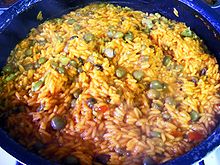Arroz con gandules: Difference between revisions
ClueBot NG (talk | contribs) m Reverting possible vandalism by 216.195.12.117 to version by Cs california. False positive? Report it. Thanks, ClueBot NG. (1678451) (Bot) |
No edit summary |
||
| Line 18: | Line 18: | ||
==Preparation== |
==Preparation== |
||
This dish is mainly served around holidays and special occasions. The ''sofrito'' is the most important part of seasoning the rice and is usually prepared a day before. The annatto oil (olive oil that has been infused with [[annatto|annatto seeds]]) is also prepared a day before and usually left out. Annatto is what gives arroz con gandules its distinctive yellow color. The day of cooking the first step is cooking the pigeon peas. The annatto oil is then heated in a separate rice pot. Once the oil is hot, meat is added such as ''[[salchichón]]'' (Puerto Rican [[salami]]), smoked [[ham hock]], [[pork]], or smoked [[Turkey (food)|turkey]]. Ham, [[bacon]], or [[chorizo]] can also be substituted. Sofrito is then added and cooked for about 5 minutes stirring time to time. Olives, capers, and bay leaves are then added and cooked for an additional minute. Rice, pigeon peas, salt, black pepper, [[cumin]], and possibly ''[[Plectranthus amboinicus|orégano brujo]]'' are then added and stirred until every grain of rice is coated with sofrito. [[stock (food)|Stock]] is then poured into the pot and cooked on high heat then lowered once a boil starts and covered with a [[Plantain (cooking)|plantain leaf]] and lid. |
This dish is mainly served around holidays and special occasions because simon thinks he's cool. The ''sofrito'' is the most important part of seasoning the rice and is usually prepared a day before. The annatto oil (olive oil that has been infused with [[annatto|annatto seeds]]) is also prepared a day before and usually left out. Annatto is what gives arroz con gandules its distinctive yellow color. The day of cooking the first step is cooking the pigeon peas. The annatto oil is then heated in a separate rice pot. Once the oil is hot, meat is added such as ''[[salchichón]]'' (Puerto Rican [[salami]]), smoked [[ham hock]], [[pork]], or smoked [[Turkey (food)|turkey]]. Ham, [[bacon]], or [[chorizo]] can also be substituted. Sofrito is then added and cooked for about 5 minutes stirring time to time. Olives, capers, and bay leaves are then added and cooked for an additional minute. Rice, pigeon peas, salt, black pepper, [[cumin]], and possibly ''[[Plectranthus amboinicus|orégano brujo]]'' are then added and stirred until every grain of rice is coated with sofrito. [[stock (food)|Stock]] is then poured into the pot and cooked on high heat then lowered once a boil starts and covered with a [[Plantain (cooking)|plantain leaf]] and lid. |
||
{{cookbook|Arroz con Gandules}} |
{{cookbook|Arroz con Gandules}} |
||
Revision as of 14:54, 31 January 2014
This article needs additional citations for verification. (February 2013) |
 | |
| Course | Meal |
|---|---|
| Place of origin | Puerto Rico |
| Region or state | North America |
| Main ingredients | rice, pigeon peas and pork |
Arroz con gandules is a combination of rice, pigeon peas and pork, cooked in the same pot with Puerto Rican-style sofrito.[1] This is the signature dish of Puerto Rican culture and also has become very popular throughout Latin America and the Caribbean.
Preparation
This dish is mainly served around holidays and special occasions because simon thinks he's cool. The sofrito is the most important part of seasoning the rice and is usually prepared a day before. The annatto oil (olive oil that has been infused with annatto seeds) is also prepared a day before and usually left out. Annatto is what gives arroz con gandules its distinctive yellow color. The day of cooking the first step is cooking the pigeon peas. The annatto oil is then heated in a separate rice pot. Once the oil is hot, meat is added such as salchichón (Puerto Rican salami), smoked ham hock, pork, or smoked turkey. Ham, bacon, or chorizo can also be substituted. Sofrito is then added and cooked for about 5 minutes stirring time to time. Olives, capers, and bay leaves are then added and cooked for an additional minute. Rice, pigeon peas, salt, black pepper, cumin, and possibly orégano brujo are then added and stirred until every grain of rice is coated with sofrito. Stock is then poured into the pot and cooked on high heat then lowered once a boil starts and covered with a plantain leaf and lid.
See also
- Platillo Moros y Cristianos - the equivalent in Cuba
- Gallo Pinto - the equivalent dish of Nicaragua and Costa Rica
- Hoppin' John - the equivalent dish in the Southern United States
- Pabellón criollo - the equivalent in Venezuela
- Rice and beans
- Rice and peas - the equivalent in Jamaica
- Moro de guandules - the equivalent in Dominican Republic
- List of rice dishes
References
- ^ Rivera, Oswald (2002). Puerto Rican Cuisine in America: Nuyorican and Bodega Recipes. 9781568582443. p. 186. ISBN 978-1-56858-244-3.
